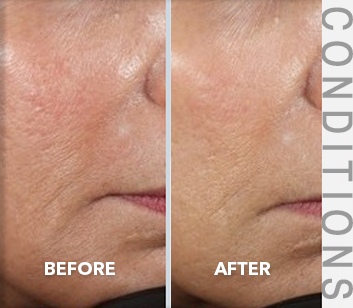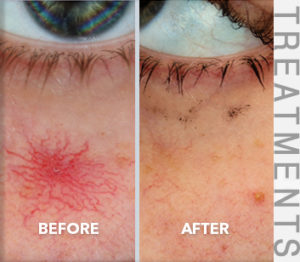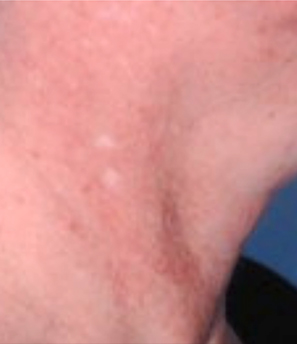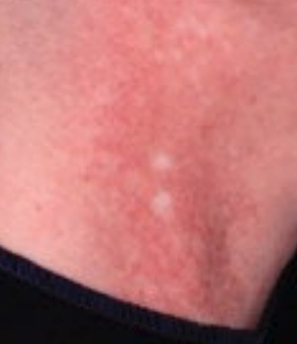Conditions
Neck Redness (POC)
Results of Treatment
Having had this treatment myself, I think it feels like I was embraced by an octopus. This swelling and redness resolves in a few days.
About Neck Redness (POC)
A common complaint with an uncommon name is sun-induced redness on the sides of the neck, called ‘Poikiloderma of Civatte’ (POC). This redness on the side of the neck results from long-term sun-exposure. The area under the chin is spared, because the chin blocks the sun in this central area. For people who drive a car a reasonable amount, the redness is greater on the left side (assuming they do not live in England where people drive on the right side of the car). Passengers would be redder on the right. This proves that sun-exposure for most of us occurs primarily in the car and not at the beach. Once the redness appears, it stays and continues to get worse. Since the blood vessels here are leaky, there is often some inflammation which results in some brown pigment mixing with the red veins. This pigmentation is a combination of brown skin pigment and the pigment from dead red blood cells (hemosiderin). I often treat this POC with a combination of topical and laser treatments. POC requires a certain degree of skill to treat with a laser, since using the wrong laser can leave the outline of the laser spot in the treated area, called footprinting, and because skin on the neck is more sensitive to laser treatments than facial skin. Sunscreen worn on the face and neck EVERY DAY, and UVA-blocking clear Llumar® or 3M® window film on one’s car are crucial to maintaining improvement during and after laser and topical treatment of POC.
To answer your specific questions or schedule a consultation, call Dr. Bernstein today at 610-645-5551.
Did you know?
Dr. Bernstein was the first physician in the WORLD to use the V-Beam Perfecta® and V-Beam Prima® lasers and one of the first in the U.S. to acquire the Excel-V® laser has published a peer-reviewed article on treating POC with the V-Beam Prima® laser.
Neck Redness (POC) FAQs
WHAT CAUSES NECK REDNESS?
The main cause of neck redness is the sun. This is quite obvious when looking at the part of the neck that is spared under the chin. This area is shaded from sun exposure. In addition, the driver’s side is redder than the passenger side in people who drive a lot, and the opposite side is redder in people who are mostly the passenger.
WHY IS NECK REDNESS CALLED POIKILODERMA OF CIVATTE?
Poikiloderma is an older term referring to mottled pigmentation of the skin. We dermatologists sound smarter when we use big words. Dr. Civatte was a French dermatologist who first described this condition. In the past conditions were more commonly named by those who first described them.
HOW MANY TREATMENTS DO I NEED?
Most people require 2-4 treatments to remove POC. More can be required, but as with most laser treatments, 2 usually a minimum.
HOW FAR APART ARE THE TREATMENTS?
Generally treatments are administered 6-8 weeks apart, but longer intervals are fine.
WILL I NEED TOUCH UP TREATMENTS?
If you continue to live in the world, you’ll need treatments to treat the new blood vessels you acquire from the sun.
WHAT CAN I DO TO PREVENT POC?
The best defense against POC is daily sunscreen and especially window film while traveling in the car. If you’re a driver, you can tell how much sun you’re getting by comparing the driver’s side to the passenger’s side of your neck. The opposite side would be more involved if you’re mostly a passenger. CLEAR, UVA-blocking window film on your car is crucial for sun-protection. You can save money on window film by just treating the side windows in the front seats.
WHY DO YOU RECOMMEND THE USE OF TOPICAL LOTIONS PRIOR TO TREATING SOME PEOPLE?
Because the neck responds much differently to sun-damage than the face or other areas of the body, the vessels that occur on the neck are net-like and leaky. This means that brownish pigmentation due to old, ruptured red blood cells, called hemosiderin, accumulates within POC. In addition, the inflammation that occurs in response to this red blood cell pigment causes the surface of the skin, the epidermis, where melanin pigment is normally present to drop down into the deeper layers of the skin, called the dermis. Topical products can help your body remove this pigmentation faster prior to laser treatment. This is important because too much pigmentation in the dermis can cause laser treatments to damage your skin.
ARE LASER TREATMENTS ON THE NECK DIFFERENT THAN THOSE ON THE FACE?
Yes. Neck skin is less forgiving than facial skin in terms of its resistance to injury from lasers. The vascular lasers are among the safest lasers in use for treating skin; however, the neck is more sensitive to laser injury than other areas of the body. This is why experienced medical personnel should perform your laser treatments.
HOW WILL I LOOK AFTER LASER TREATMENT?
The neck gets red after laser treatment for POC, with dime-sized bumps due to swelling. Having had this treatment myself, I think it feels like I was embraced by an octopus. This swelling and redness resolves in a few days. Bruising is also typical following treatment of POC and can last 1-2 weeks. It’s not as noticeable as when this bruising occurs on the face and is more easily covered with clothing or make-up.
WHAT DO I NEED TO DO FOR AFTER CARE?
After laser treatment of POC, most people can resume their normal skincare regimen on the neck with mild moisturizers. Petrolatum, Vaseline® or Aquaphor® ointment, can be applied for any irritation.







